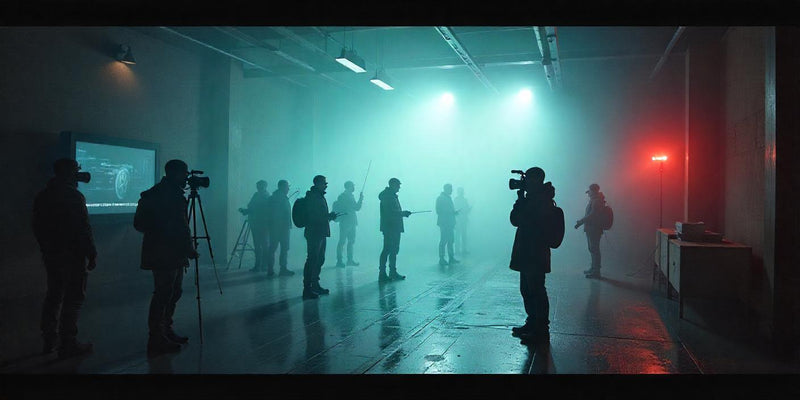CAVE Technology vs Traditional Film Sets: Production Efficiency Comparison

The film industry stands at a crossroads between time-tested traditional filmmaking methods and revolutionary virtual production technologies. While conventional film sets have dominated Hollywood for over a century, CAVE technology presents a compelling alternative that challenges every assumption about how movies should be made. This detailed analysis examines the critical differences between CAVE vs traditional sets, providing filmmakers with the data needed to make informed production decisions.
Understanding the Two Approaches: Virtual vs Physical Sets
Traditional film sets represent the foundation of cinema, requiring physical construction, location scouting, and extensive logistical coordination. These tangible environments provide actors with real spaces to inhabit and give directors complete control over physical elements like lighting, weather, and spatial dynamics.
CAVE systems create immersive virtual environments through sophisticated projection technology, motion tracking, and real-time rendering. These digital spaces allow filmmakers to construct any conceivable setting without physical limitations, enabling instant modifications and unlimited creative possibilities.
The fundamental difference lies in the relationship between physical and digital elements. Traditional sets prioritize tangible reality, while CAVE technology prioritizes flexible digital creation with selective physical integration.
Production Cost Analysis: Breaking Down the Numbers
Traditional Film Set Expenses
Physical film production carries substantial upfront and ongoing costs that accumulate throughout the production timeline. Location fees range from $1,000 to $100,000 per day for premium venues, with additional expenses for permits, insurance, and location modifications. Set construction costs vary dramatically based on complexity, typically ranging from $50,000 for simple interior sets to $2 million for elaborate practical environments.
Equipment transportation represents another significant expense, with trucks, generators, catering services, and crew transportation adding $10,000 to $50,000 daily to production budgets. Weather delays, location availability conflicts, and unexpected technical issues frequently push costs beyond initial projections.
Labor costs for traditional productions include large crews for construction, transportation, setup, and breakdown activities. A typical feature film set requires 50-150 crew members for location shooting, with daily rates adding substantial expense to production budgets.
CAVE Technology Investment Structure
CAVE system implementation requires significant initial capital investment, typically ranging from $500,000 to $3 million for professional-grade installations. However, this represents a one-time infrastructure cost that serves multiple productions over many years.
Operational expenses for CAVE productions focus on software licensing, technical specialists, and facility maintenance. Daily operational costs typically range from $2,000 to $8,000, significantly lower than traditional location shooting expenses.
The economic model shifts from per-project expenses to amortized infrastructure investment. Studios using CAVE technology frequently achieve cost neutrality within 2-3 major productions, with subsequent projects benefiting from dramatic cost reductions.

Time Efficiency and Production Speed
Traditional Production Timelines
Conventional filmmaking follows established but time-intensive workflows. Pre-production phases include location scouting, set design, construction, and testing, often requiring 8-16 weeks for complex projects. Principal photography timelines depend heavily on location availability, weather conditions, and logistical coordination.
Setup and breakdown procedures consume significant portions of shooting schedules. Moving between locations requires 2-6 hours daily for equipment transportation and setup, reducing actual filming time. Weather delays, permit complications, and location conflicts frequently extend production schedules by 20-40%.
Post-production visual effects work often requires extensive green screen replacement, digital set extensions, and environmental corrections, adding months to project timelines.
CAVE Production Efficiency
Virtual production using CAVE technology compresses traditional timelines through parallel workflow development. Set design, lighting design, and scene blocking occur simultaneously within the virtual environment, reducing pre-production phases to 3-6 weeks.
Real-time scene modifications eliminate traditional reshooting requirements. Directors can adjust lighting, weather, time of day, or environmental elements instantly without crew repositioning or equipment changes. This flexibility reduces shooting schedules by 30-50% compared to traditional methods.
Post-production benefits from reduced visual effects requirements, as CAVE environments provide finished backgrounds and lighting during principal photography. Color correction and compositing work decreases significantly, shortening post-production timelines by 40-60%.
Creative Flexibility and Artistic Control
Traditional sets provide directors with complete control over physical elements but limit creative options to constructed or available environments. Set modifications require time, labor, and additional costs, making creative experimentation expensive and logistically challenging.
CAVE environments offer unlimited creative possibilities constrained only by computing power and artistic imagination. Directors can instantly transport productions between different time periods, planets, or fantastical realms without physical reconstruction.
The ability to preview and refine shots in real-time allows directors to perfect scenes before committing to final photography. This iterative approach improves creative outcomes while reducing expensive reshooting requirements.

Technical Quality and Visual Results
Traditional Set Advantages
Physical environments provide authentic lighting, shadows, and atmospheric effects that remain challenging to replicate digitally. Actors respond naturally to tangible surroundings, often delivering more authentic performances in real environments.
Practical effects, weather elements, and environmental interactions create genuine visual dynamics that enhance cinematographic realism. The tactile nature of physical sets allows for natural camera movements and authentic spatial relationships.
CAVE System Capabilities
Modern CAVE installations deliver 4K to 8K resolution imagery with high dynamic range color reproduction that matches or exceeds traditional cinematography standards. Advanced motion tracking ensures perfect perspective alignment for all camera positions and movements.
Real-time rendering technology now produces photorealistic environments indistinguishable from practical locations in final footage. Lighting simulation accurately replicates natural and artificial light sources with precise shadow casting and environmental reflections.
The integration of physical props and set pieces within virtual environments creates hybrid productions that combine the benefits of both approaches while minimizing the limitations of each.
Scalability and Project Scope Considerations
Traditional film production scales linearly with project complexity. Larger sets, more locations, and extended shooting schedules proportionally increase costs and timelines. International filming locations multiply expenses through travel, accommodation, and local production requirements.
CAVE technology scales more efficiently, as virtual environments require similar computational resources regardless of complexity or exotic locations. A single CAVE installation can represent any number of locations without additional travel or construction expenses.
Multiple productions can utilize the same CAVE infrastructure simultaneously through scheduling optimization, maximizing facility utilization and improving return on investment for production companies.

Environmental Impact and Sustainability
Traditional film production generates substantial environmental impact through set construction materials, transportation emissions, and location disruption. Large productions consume significant resources and produce considerable waste through temporary construction and demolition activities.
CAVE virtual production reduces environmental impact by 60-80% through eliminated transportation requirements, reduced material consumption, and decreased energy usage per production. Digital set creation produces no physical waste and enables sustainable production practices.
The ability to reuse and modify virtual environments across multiple projects further reduces environmental impact while providing economic benefits to production companies.
Industry Adoption Patterns and Future Trends
Major studios including Disney, Warner Bros, and Netflix have invested heavily in virtual production capabilities, indicating industry confidence in CAVE technology potential. Independent filmmakers increasingly access CAVE facilities through rental agreements and shared resources.
Film production comparison data from recent projects shows consistent cost savings of 25-45% and timeline reductions of 30-50% for CAVE-enabled productions. These efficiency gains drive continued industry adoption and technology development.
Educational institutions now integrate virtual production training into film programs, ensuring future filmmakers develop expertise in both traditional and CAVE production methodologies.
Making the Right Choice for Your Production
The decision between CAVE vs traditional sets depends on specific project requirements, budget constraints, and creative objectives. Traditional methods remain optimal for productions requiring authentic historical locations, specific regional authenticity, or minimal post-production budgets.
CAVE technology provides superior efficiency for science fiction, fantasy, or visually complex productions requiring multiple exotic locations or impossible physical environments. Productions with tight schedules, limited location access, or extensive visual effects requirements benefit significantly from virtual production approaches.
Hybrid approaches combining practical elements with virtual environments often provide optimal results, leveraging the strengths of both methodologies while minimizing their respective limitations.

Conclusion
The film production comparison between CAVE technology and traditional film sets reveals clear advantages for virtual production in terms of cost efficiency, timeline compression, and creative flexibility. While traditional filmmaking methods retain certain artistic and practical benefits, CAVE systems provide compelling economic and operational advantages that make them increasingly attractive for modern film production.
CAVE system benefits include dramatic cost reductions after initial investment, compressed production timelines, unlimited creative possibilities, and improved environmental sustainability. Traditional filmmaking costs continue to escalate due to location expenses, labor requirements, and logistical complexity.
The most successful productions of the future will likely combine both approaches strategically, using CAVE technology for complex or impossible environments while maintaining traditional methods for intimate, character-driven scenes requiring authentic human interaction with physical spaces.
As technology continues advancing and costs decrease, CAVE virtual production will become the standard for major film productions, with traditional sets serving specialized artistic and practical purposes within the broader filmmaking ecosystem.
Frequently Asked Questions
Q: How much does CAVE technology cost compared to traditional film sets?
A: CAVE systems require $500,000-$3 million initial investment but reduce per-project costs by 25-45%. Traditional sets cost $50,000-$2 million per production with ongoing location and labor expenses. CAVE technology typically achieves cost neutrality within 2-3 productions.
Q: Can actors perform naturally in CAVE virtual environments?
A: Yes, modern CAVE systems provide immersive environments where actors can move naturally without VR headsets. The 360-degree projections create convincing surroundings that support authentic performances while allowing normal director-actor communication.
Q: What types of films benefit most from CAVE technology?
A: Science fiction, fantasy, action films with exotic locations, and productions requiring multiple environment changes benefit most. Films needing authentic historical locations or intimate character studies may still prefer traditional sets.
Q: How long does it take to set up CAVE environments compared to traditional sets?
A: CAVE environments can be created and modified in real-time during production, while traditional sets require 8-16 weeks for construction. Virtual production reduces overall production timelines by 30-50%.
Q: Do CAVE systems produce cinema-quality visuals?
A: Modern CAVE installations deliver 4K-8K resolution with high dynamic range that meets or exceeds traditional cinematography standards. The final footage quality is indistinguishable from practical locations when properly implemented.
Q: Can CAVE technology completely replace traditional film sets?
A: While CAVE systems offer significant advantages, complete replacement isn't practical for all productions. Hybrid approaches combining virtual environments with practical elements often provide optimal results for different scenes within the same film.
Q: What are the main limitations of CAVE virtual production?
A: Current limitations include high initial investment costs, requirement for technical expertise, and challenges with certain practical effects like water, fire, or complex physics interactions that may still require traditional approaches.
Q: How do production schedules differ between CAVE and traditional filming?
A: CAVE productions typically complete principal photography 30-50% faster due to instant environment changes, weather control, and reduced setup times. Post-production is also shorter due to reduced visual effects requirements.




